How did the young ladies from the institutes of noble maidens really live
Categories: History
By Pictolic https://pictolic.com/article/how-did-the-young-ladies-from-the-institutes-of-noble-maidens-really-live.htmlOn May 5, 1764, 257 years ago, the Smolny Institute of Noble Maidens was founded in St. Petersburg. Life in such institutions, contrary to popular misconceptions, was not sugar. The infirmary was perceived by the students as a resort, any male teacher, even with a defect, is doomed to adoration, and the institute was not allowed to do anything. How did the young ladies get out?
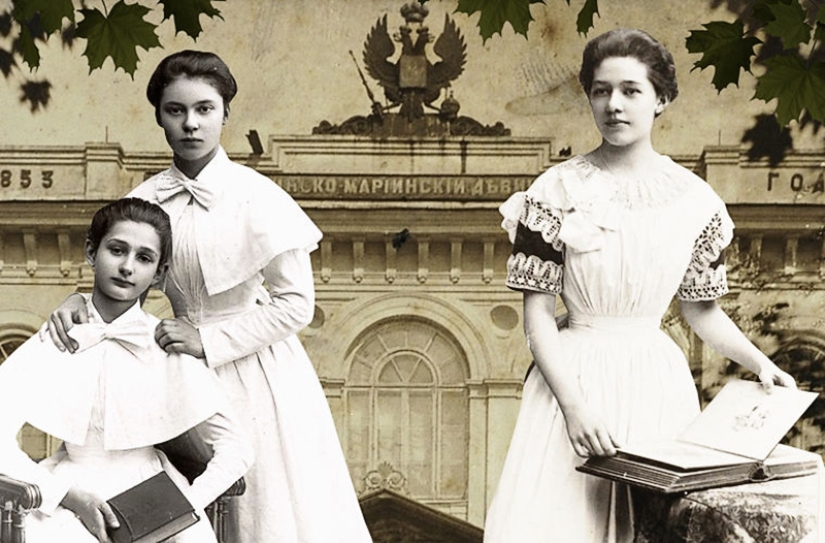
They were called institute girls or muslin ladies-graduation dresses were made of muslin. The owner of these titles was distinguished by infantile, eccentric, sentimental. She could jump for joy and clap her hands, wring her hands in public, sob for any reason, and faint a little. Such a violent reaction to the environment was explained by many years of isolation from the outside world.
In 1764, the Educational Society of Noble Maidens was established in St. Petersburg, which later became the Smolny Institute-the first women's educational institution in Russia. Considering that the need for women's education had previously been called into great doubt, the case was truly revolutionary. The decree of Catherine II stated that the purpose of the establishment of the institution is "to give the state educated women, good mothers, useful members of the family and society." The institute existed for a century and a half (until 1917), the "spirit of enlightenment" disappeared, and the barracks remained. Getting around them was also a science.
All are divided into parfetok and moveshek

Kharkiv Institute of Noble Maidens. October 6, 1915.
The first rank went to those who were perfect (from the French parfaite) in all respects, knew how to behave comme il faut, respond politely, curtsy gracefully and always keep the body straight. Those deprived of these virtues were called moveshkami (from mauvaise — "bad"). You could get into their number for a carelessly made bed, a loud conversation, a torn stocking or a stray lock of hair. Corporal punishment was not applied, but the violators were severe: the apron was replaced with a special teak one, they were transferred to a special table in the dining room, where they had to eat standing up, or they were left standing motionless in the middle of the dining room for the entire time of dinner. But some rebelled against the order consciously. Such moveshki on conviction ("desperate") is much more interesting than parfetok.
The color of the clothes is not chosen
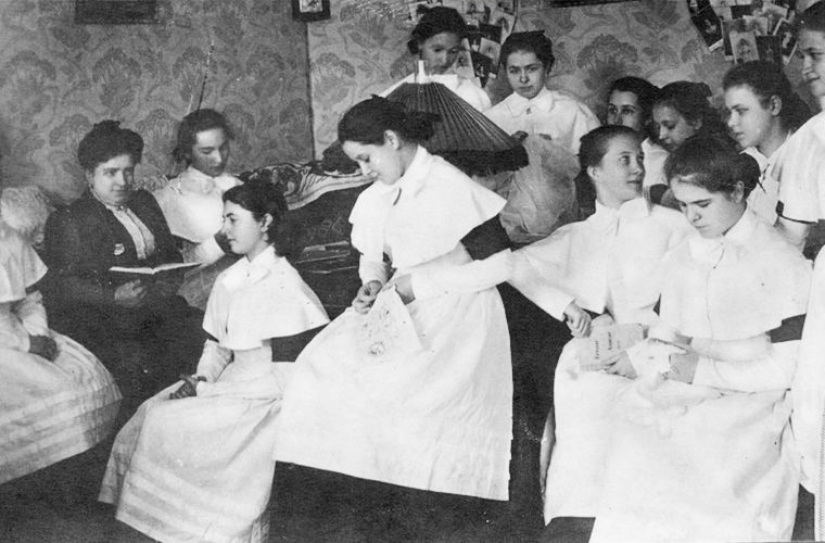
A group of students of the Smolny Institute in ball gowns.
The students wore uniforms that varied in color depending on their age. The younger ones had practical coffee dresses (for which they were called coffee girls or coffee girls) with white aprons. The middle ones are blue, the older ones are white with green aprons. The Pepin girls (those who stayed after the end of the main course in order to "grow up" to be a class lady) had gray outfits. Many girls were kept in Smolny at the expense of private scholarships. Such young ladies wore a ribbon with the color of the benefactor around their neck. So, the scholarship holders of Emperor Paul I had blue ribbons, the Demidovs — orange, the Saltykovs — crimson. Other girlish things were kept in boxes or hidden on the chest.
Teachers — only "married", elderly and with a defect
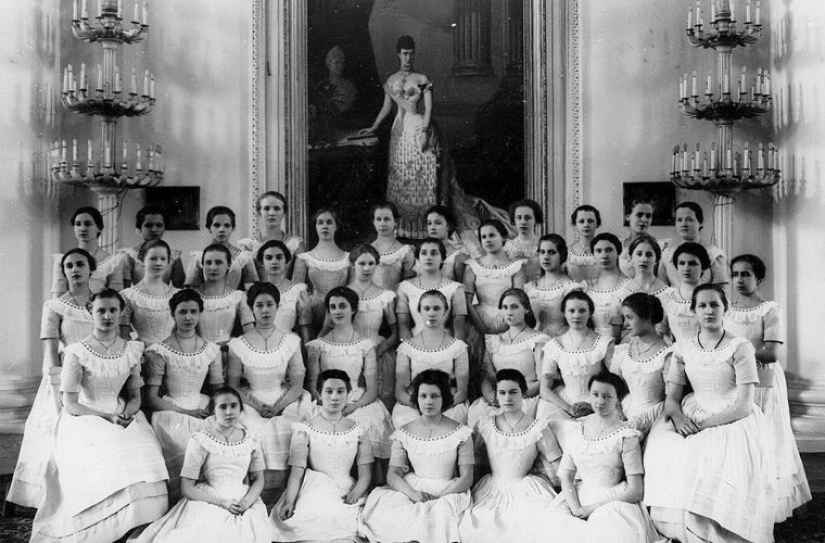
A group of teachers of the Smolny Institute.
Male teachers in Smolny were taken exclusively married, if possible elderly, and even better-with some kind of defect in appearance. But their fans were not transferred. They gave gifts to the idol, poured perfume on his hat, pinned out the initials of the celestial, ate soap in his honor, and made their way to the local church at night, praying for his well-being. The eldest pupil could also be the object of worship, but adoration went beyond all bounds when it came to the emperor. "Slices of roast meat, cucumber, bread" from the table where His Majesty dined were collected and stored as precious talismans. The royal handkerchief, which happened to be in the hands of the young ladies, was cut into pieces and divided into all, "to be worn on the chest." It was necessary to adore someone.
You can sleep it off in the infirmary
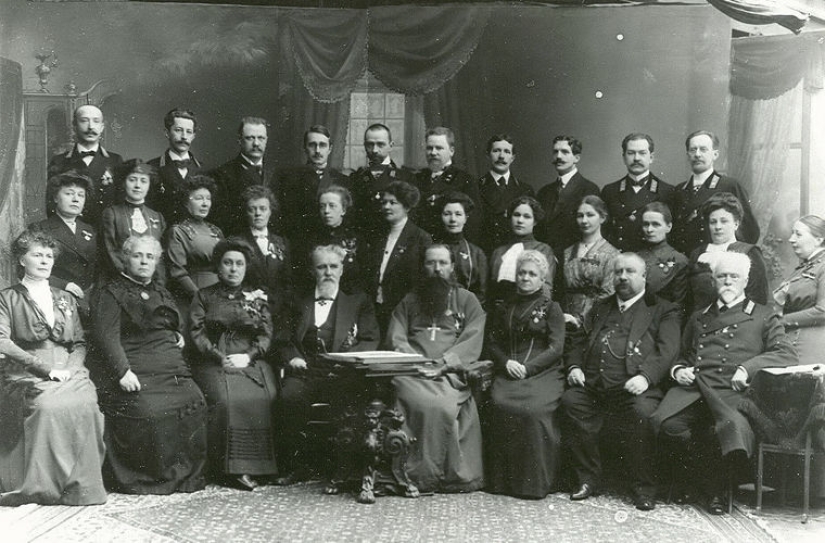
Smolny Institute. 1889.
The temperature in the dormitory did not exceed 16 °C. The mattresses are hard. Getting up at 6 in the morning, washing with cold Neva water, up to eight lessons a day-this is how noble girls were tempered. It was possible to warm up and sleep off in the local infirmary, where the young ladies, who perfectly mastered the art of fainting, easily fell.
You can't step on the snow
For winter festivities, Smolny alleys were covered with boards. The pupils walked exclusively on their own territory and only once a year, in the summer, they were taken to the Tauride Garden, from where all visitors were previously expelled. It was considered a great feat to drag a nearly melted snowball into the room with you.
It is forbidden to read books outside of the program

A group of students of the Smolny Institute in the living room for embroidery and reading.
In order not to gain harmful ideas and to preserve the innocence of thoughts, which the teachers were so concerned about. It got to the point that the seventh commandment of the Law of God ("Thou shalt not commit adultery") was sealed with a piece of paper. For the institutes, there were special editions of the classics, in which there were more ellipses than text. Varlam Shalamov wrote that " the discarded places were collected in a special last volume of the publication, which students could buy only after graduation. It was this last volume that was the object of special desire for female students." If a book could be obtained, it had to be carefully hidden.
Meetings with relatives — according to the schedule and in front of witnesses

Four hours a week on weekends-in the presence of caregivers. Girls who spent nine years in the walls of Smolny (from 9 to 18) were not allowed to go home. Correspondence with relatives was controlled: both "incoming" and "outgoing" were read by the class ladies. So the pupils were protected from the harmful influence of the outside world. Parents had no right to stop studying at will and take their daughter home, it was impossible to meet more often, but in order to send letters "bypassing censorship", it was only necessary to pay the maid.
It is necessary to eat without frills
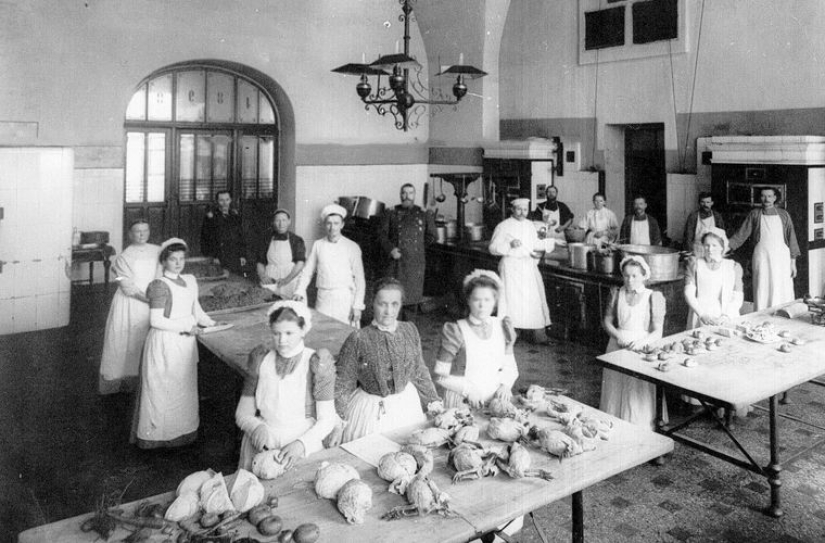
The pupils are in the kitchen preparing dinner.
Here is the usual menu for the day. Breakfast: bread with butter and cheese, milk porridge or pasta, tea. Lunch: liquid soup without meat, meat from soup, pie. Dinner: tea with bread roll. On Wednesdays, Fridays, and fasts, the diet was tightened even more: lean soup with cereals, a small piece of boiled fish, nicknamed "dead meat" by the institute students, and a small lean pie. It was possible to expand the diet with the help of pocket money. If you pay the maid, she'll sneak in some food.
The dormitory should be quiet after lights out
Before going to bed, stories about white ladies, black knights, and severed hands were popular in the bedrooms. The walls were good for that: the legend of the immured nun was associated with Smolny. The storytellers staged a real theater of horror, moving from a terrible whisper to a terrible bass and periodically grabbing their listeners ' hands in the dark. It was very important not to squeal in fear.
Life after graduation is a celebration. Is it true?
When confronted with the real world, this confidence created what is now called cognitive dissonance. In everyday life, the institute girls were completely helpless. "Immediately after leaving the institute," recalled the graduate Elizaveta Vodovozova, " I had no idea that first of all I should agree with the driver about the price, I did not know that he had to pay for the fare, and I did not have a purse." It remained only to make infantileness its highlight-innocently blink your eyes and speak in a touching childish voice, to save the "innocent child" there.

Princess Praskovya Gagarina.
P. S. Many graduates of Smolny went down in history. Among them are the first Russian balloonist Princess Praskovya Gagarina; one of the leaders of the White Guard Union (ROVS), a terrorist and intelligence officer Maria Zakharchenko-Schultz; Baroness Sophia de Bode, who commanded a cadet squad in 1917 and was remembered by contemporaries for her incredible bravery and cruelty; "iron woman" Maria Zakrevskaya-Benckendorf-Budberg, a double agent of the OGPU and British intelligence and the beloved of Maxim Gorky; the famous harpist Ksenia Erdely, as well as one of the first futurists, the poet Nina Habias.

Maria Zakharchenko-Schultz in a jockey costume.
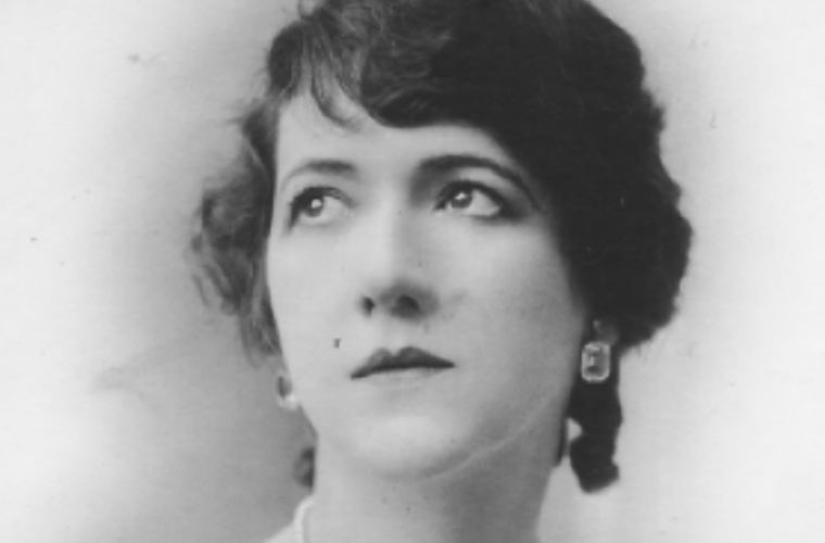
Maria Zakrevskaya-Benckendorf-Budberg.
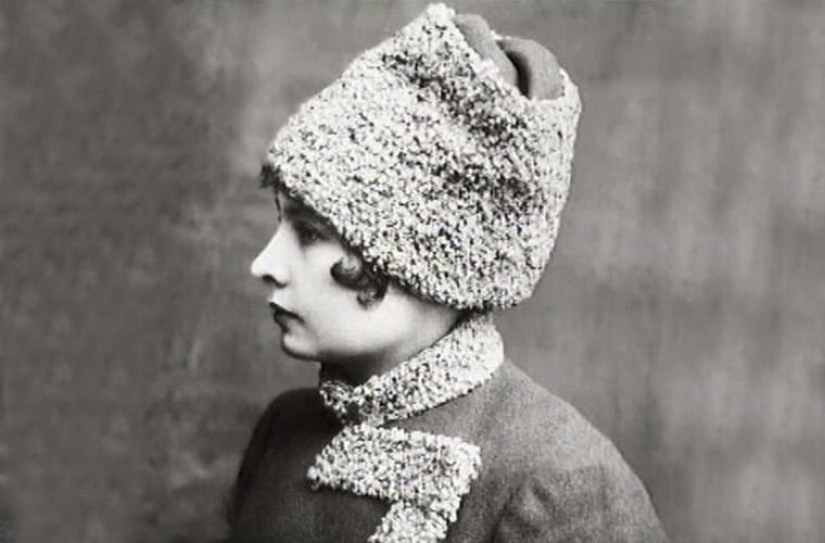
Baroness Sophia de Bode.
Keywords: Russian Federation | History | Girls | Education | Life | Institute
Post News ArticleRecent articles

It's never too late to learn something new! And thanks to the Reddit community "Today I found out" it can be done easily and ...

Since the release of the first production car, the automotive world has evolved, perhaps, every decade. Models of a certain era are ...
Related articles

In the first two decades of the XX century, against the background of technological progress, the development of photography, ...

We are used to seeing Soviet actors and singers on the TV screen, occasionally in photos from personal archives in TV programs. But ...

March 21, 1963 was closed to the famous American prison for dangerous criminals Alcatraz, also known as "the Rock". Located on the ...

Watch how flower is formed by the ovary, such as into the fruit and as he poured the juice – a great experience. At least in the ...